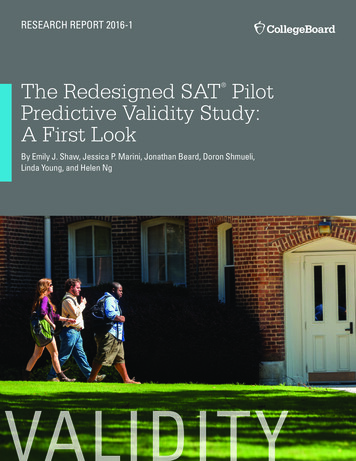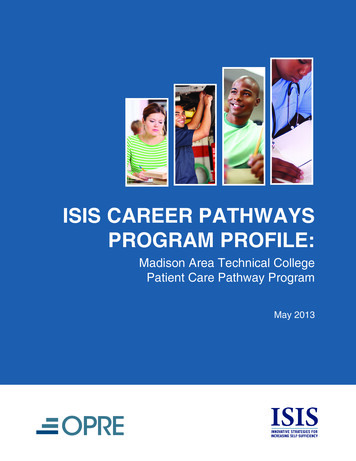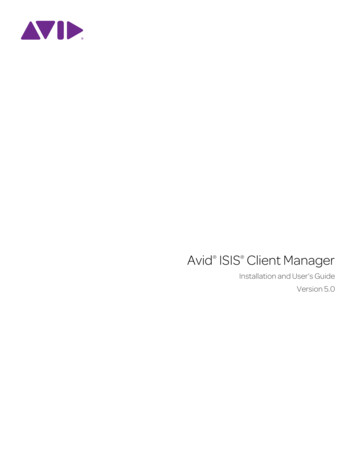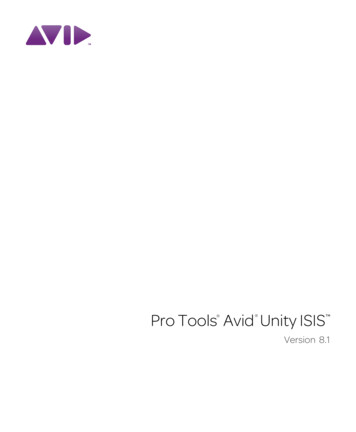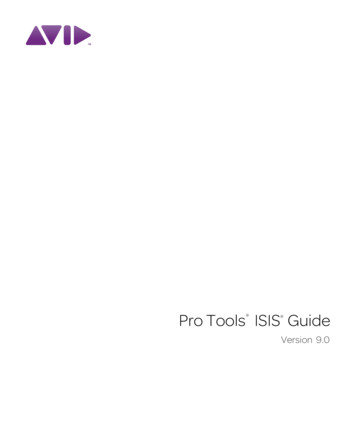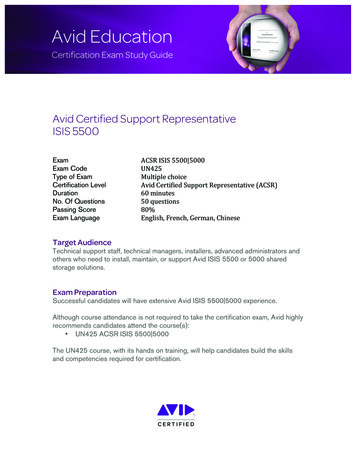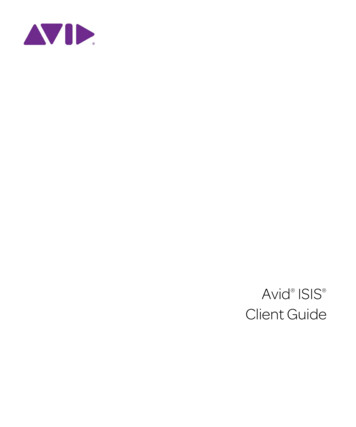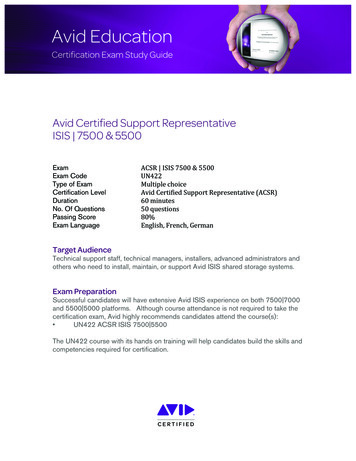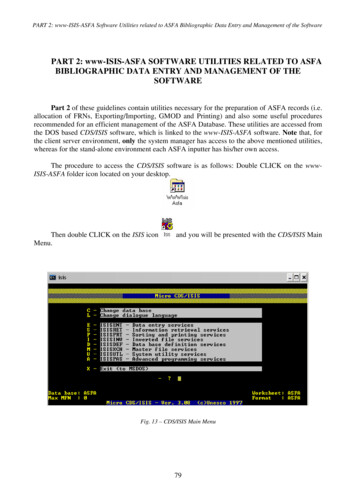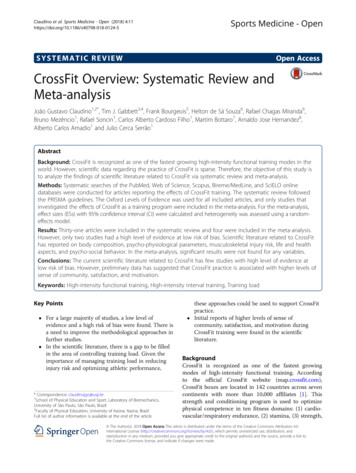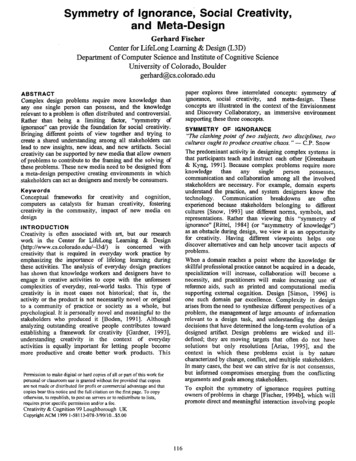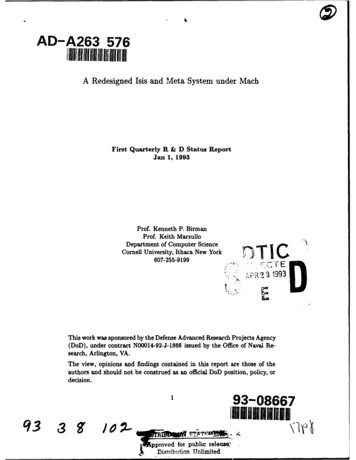
Transcription
AD-A263 576A Redesigned Isis and Meta System under MachFirst Quarterly R & D Status ReportJan 1, 1993Prof. Kenneth P. BirmanProf. Keith MarzulloDepartment of Computer ScienceCornell University, Ithaca New York607-255-9199'7 T1. -R 3 19 93This work was sponsored by the Defense Advanced Research Projects Agency(DoD), under contract N00014-92-J-1866 issued by the Office of Naval Research, Arlington, VA.The view, opinions and findings contained in this report are those of theauthors and should not be construed as an official DoD position, policy, ordecision.93-08667q3SIo-IlIUHIulIIIHIIII pproved fot public xelease,SDistribution Unlimited
Personnel"* Academic Staff:- Prof. Kenneth P. Birman, Co-Investigator- Prof. Keith Marzullo, Co-Investigator- Dr. Robert Cooper, Research Associate- Dr. Robbert van Renesse, Research Associate- Dr. Aleta Ricciardi, Post-doctoral Research Associate"* Graduate Students:- Lorenzo Alvisi (Marzullo)- Navin Budhiraja (Marzullo)- Brad Glade (Birman)Accesion For- Guerney Hunt (Birman)NTIS- Neil Jain (Birman)DTIC TABUnannouncedJustification- David Karr (Birman)- Michael Kalantar (Birman)CRA&IBy .Oistibution I- Michael Reiter (Birman)- Aleta Ricciardi (Birman)Availability Codes- Laura Sabel (Marzullo)DistAvail a:',d orSpecialN-I2QUALITY LBP-Cm 42
The Isis projectThis status report covers activities of the Isis project during the first quarterof 1992. This is our 1'st progress report under ONR funding, but becausethese status reports are intended to be brief and our proposal was recentlyfunded, we assume that the reader has some background regarding the goalsand status of our effort, and focus instead on technical accomplishmentsduring the report period and goals for the next three months. Readersunfamiliar with our work could start by reading some of the papers citedbelow, such as TR 1216.During the report period, the Isis effort has achieved a major milestone in itseffort to redesign and reimplement the Isis system using Mach and Chorus astarget operating system environments. In addition, we completed a numberof publications that address issues raised in oar prior work; some of thesehave recently appeared in print, while others are now being considered forpublication in a variety of journals and conferences.With the completion of this milestone, we look to 1993 as a year duringwhich our new system will be implemented and fully integrated in to Mach,Chorus, and other mikrokernel operating systems, and during which a majoreffort in the real-time area will be launched.The major accomplishments of this final quarterly report period are as follows (if this list seems long, recall that ONR funding picks up from previousDARPA funding over what is now a six year period, hence our project is amajor one in its mature stage, and can be expected to be fairly productive):e We completed the design and prototype implementation of our new"lightweight groups" facility, which will eventually run in Mach orChorus. This is a major practical advance for the group, which hasbeen working on this problem for the past two years. Although ournew system has yet to be integrated with Mach, it does implement thelightweight causal and atomic multicast protocols of our 1991 ACMTOCS paper, support the causal domain model that we introduced recently, and achieves extremely high performance and parallelism evenover UNIX. We are extremely encouraged by this development. Predictions of a 10- to 100-fold performance improvement appear to bejustified, but until we have this new software running under nativeMach it will be difficult to say anything final on the issue.3
" We debugged the new system to the point of being able to demonstrateit at a recent research workshop sponsored by IBM. The system itselfworked well, including our new security architecture, described furtherbelow." We continued work on a new way of presenting Isis groups that willreduce costs by allowing Isis to map multiple application-level processgroups to a single Isis process group. The idea here is to amortizemembership changes over multiple groups so as to reduce their effectivecost. The technique us expected to avoid high overhead in applicationsthat use very large numbers of nearly identical groups." Formation of research ties with other laboratories, inclue-'ng the LosAlamos Advanced Computing Laboratory (which focuss,3 on supercomputing), Portugal's INESC research laboratory (known for its workon realtime communication), and with Mach-related research effortsat the Open Software Foundation, Carnegie Mellon, and University ofArizona." We continued the development and initial implementation of the newsecurity architecture for Isis, which focuses on securing islands of Isisusers within hostile networks, and on securing Isis abstractions evenwithin these islands. We view this as an extremely important advance,because the previous version of Isis was almost completely trusting ofits users. The secure Isis architecture, in contrast, can tolerate arbitrary failures outside a collection of physically secure nodes, andsupports a highly sophisticated trust, encryption and delegation architecture within an island of secured nodes. Implementation of thisarchitecture is proving to be a cornerstone of our new system, andwith the successful demonstration of the technology cited above, weare close to being able to support users."*We completed the implementation of a Meta rule manager. This decentralized Isis program can be thought of as a "run-time" environmentthat dynamically loads Meta rules onto instrumented components asthey become active or recover from crashes. The rule manager operates from a description of the instrumented program (much like theschema of an object-oriented database) and allows a user to makesimple queries about the status of the instrumented program.4
The lack of such a rule manager has been a major stumbling block tothe clients of Meta. We are also continuing to expand its function intoa full-fledged runtime system. We plan to add support for interactivelydebugging active Meta rules and to add graphical tools for monitoringthe status of the application." We are completed the design of a higher-level language for Meta.This has proven to be more difficult than we thought since the differences between what appear to be reasonable semantics of temporalcommands are subtle. The new language is being implemented, andwill replace a simpler version of Lomita that only supports Meta-styleguarded commands and rules for maintaining the membership of aggregates. This compiler produces object files that are read by the rulemanager mentioned in the previous item which in turn activates ruleson the instrumented application.The main drawback with the previous, simple version of Lomita is thelack of control flow structures-for example, recovery when some control rule terminates abnormally. Hence, we are extending the functionof the Meta shell actuator to allow sensor values to be passed in asenvironment variables. Combined with a shell command that accessesMeta (also nearing completion), this will allow a programmer to writeshell scripts that are invoked by Meta as actuators. Such scripts canboth record state for temporal matching and perform complex controlfunctions by using both Unix features and Meta sensors and actuators."* Almost all of the applications that Meta has been used for outside ofCornell have used the sensor abstractions of Meta much more thanthe actuator abstractions. We think that part of this is due to thelack of rule support mentioned above, but it is also somewhat dueto the lack of a good example that could be distributed with Meta.Hence, we have built such an example application that uses Metato load balance requests to a set of simulated computation servers.Writing this application has (not unexpectedly) flushed out a set ofsubtle bugs in Meta and Isis, and so the example application is notready for distribution at the time this report was written. It currentlyexhibits simple rules (such as transparent submission to lightly-loadedservers) and we are currently adding more complex control rules (suchas dynamic server creation and removal based on average service load).5
We are also rewriting the Isis Resource Manager as a Meta client.Again, this has flushed out a set of problems with Meta (most notably, the lack of support for remote Isis and the lack of support oflarge aggregates). We expect to have the Isis Resource Manager fullyfunctional as a Meta client by the end of 1992." We have made substantial progress in a new experimental effort tounderstand flow control problems on hardware multicast technologiessuch as ethernet, FDDI and token ring, and are extending our workto include next-generation technologies such as ATM. The goal of thiseffort is to develop effective flow-control algorithms for use within theIsis multicast protocols. So far, we have focused on collecting data concerning the behavior of the raw devices themselves, and have obtainedfascinating and non-intuitive results concerning packet loss rates in anumber of settings. These show that the most significant loss rates arefor small packets sent in many-one or many-many situations. Low orzero loss occurs with large packets and for one-many patterns. Thisinformation will be used to develop algorithms that narrow in on thesituations in which loss rates are highest, while remaining uninvolvedin other situations. Such flow control algorithms are the key elementlimiting Isis performance on many systems, and development of thisnew flow control software will be a small but critical activity for usduring the coming year." We have initiated a new project to explore specialized implementationsof Isis for the CM/5 and Intel Touchstone multiprocessors. This workis motivated by the impressive results of Berkeley's Spllt/C and Active Messages research, demonstrating that asynchronous communication can lead to tremendous performance gains on the most importantemerging parallel processors. As we move Isis onto these platforms,we want to build our protocols in ways that exploit the hardware fullyand minimize unnecessary work in software - work needed on networksbut not on closely coupled machines. We are very excited about thisnew direction." Finally, and last only because the effort is one that started recently,we have begun to explore the integration of realtime support into Isis,through a project called CORTO. Our goals are fairly modest for thiseffort, at least initially, because we wish to build something usablewhich we can later extend with sophisticated schedulers and other6
adjuncts. In the near term, CORTO will focus on adding periodicprocess groups and realtime group communication to Isis.With this first progress report, it is interesting to observe that Isis seemsalso at the end of a period of initial transition. The original version of Isisis no longer a subject of active research at Cornell, and the initial versionof the Meta system is also finished. With the successful handoff of thesesystems to ISIS Distributed Systems (and the widespread release of public,source-form distributions), technology transition for this version of ISIS iswell established, and Cornell is now free to focus on the development of thenext generation of this technology.Users of the first generation technology include Sematech, Hughes (EOS),GE/Motorola (Iridium), the military (HiperD), the financial community(New York Stock Exchange, World Bank, many banks and brokerages),CERN, Los Alamos, FermiLab, GTE, SouthWestern Bell Telephone, andmany other large and small companies, both for commercial and for research purposes. DARPA and Nasa, though support for Isis, have created anew technology that is clearly having an enduring impact on the way thatdistributed systems are developed in the United States and worldwide.On the research side, the success of Isis and Meta have launched a majorwave of activity in the O/S community. Hundreds of papers have beenwritten by dozens of research groups on variations of the Isis approach. Thetechnology can only improve from this type of activity, and there can be noclearer proof that the approach is valid and viable.Our own redesign of Isis has been structured around a much simplified core ofprotocols and system management routines (a sort of "micro-kernel"). Thiscore is flexible enough to support all existing Isis functionality, as well as realtime applications, secure applications, a version of the Isis toolkit optimizedfor parallel processing environments, and support for object-oriented andmodular programming languages, like C and ADA. We are building thisnew software layer so that it can run directly over the Mach and Choruskernels, while continuing to support a UNIX-level interface similar to ourcurrent toolkit interface.A final comment relates to our continued and enlarging discussions withindustry. We are now actively pursuing standardization of the Isis approachto group computing with Unix Systems Laboratories, Unix International, theOpen Software Foundation, the Texas Instruments/DARPA OODB project,7
Electronic Joint Venture, and other standards organizations. This is havingsignificant impact, as demonstrated by the decision of OSF to integrate Isisinto OSF 1/AD and the recent announcements by Unix International andUSL concerning the key role that reliable process group technologies will playin their future products. We are increasingly joined by "ndustry strategistsin recognizing Isis and META as enablers for a whole new generation ofhighly reliable, large-scale, self-managing distributed software. We believethat DARPA and ONR can point to this emerging trend as a demonstrationof the huge impact that government research activities can have on industry,given sufficient time, sufficient investment, and consistently positive resultsto point to.8
First Budget Statem -Iuta.AIPA Order Number:7019b.Contract Number:N00014-92-J-1866c.Agent:ONRd.Contract Title:A Redesigned Isis and Meta System Under Mache.Organization:Cornell Universityf.PIs:Kenneth P. Birman and Keith Marzullog.Actual Start Date:9/30/92h.Expected End Date:12/30/95i.Expected End Date if OptionsExercised:NAj.Total Price: 3,137,518k.Spending Authority ProvidedSo Far: 1,281,331I.Expenditures through 12/31/92 250,000m.Date When These Funds WillBe Fully Expended:12/31/92n.Additional Funds Expected PerContract (by FY):9FY94 928,050FY95 928,137
PUBLICATIONS LIST Continued91-1257*Design Alternatives for Process Group Membership & Multicast (replaces TR 91-1185). Kenneth Birman, Robert Cooper, and Barry Gleeson. December 1991. Submitted to IEEE Transactions on Parallel andDistributed Systems.91-1249*Tools and Techniques for Adding Fault Tolerance to Distributed andParallel Programs. Ozalp Babaoglu. December 1991.91-xxxxLower Bounds for Primary-Backup Implementations of Bofo Services.Navin Budhiraja, Keith Marzullo, Fred B. Schneider and Sam Toueg.Proceedings ONR 2nd Annual Workshop on Ultradependable Multicomputers and Electronic Systems, Washington, DC, (November 1991), 8186.91-xxxxDML: Packaging High-Level Distributed Abstractions in SML. CliffordD. Krumvieda. September 1991. Proceedings of the Third InternationalWorkshop on Standard ML, Robert Harper (ed.), Department of Computer Science, Carnegie Mellon University, September 26-27, 1991.91-1225*Unreliable Failure Detectors for Asynchronous Systems. Tushar Deepakchandra and Sam Toueg. August 1991.91-1217*Derivation of Sequential, Real-Time, Process-Control Programs. NavinBudhiraja, Keith Marzullo and Fred B. Schneider. July 1991. In Foundations of Real-Time Computing: Formal Specifications and Methods,Kluwer Academic Publishers 1991, pp. 39-54. Navin Budhiraja, KeithMarzullo and Fred B. Schneider. July 1991.90-1141*MTP: An Atomic Multicast Transport Protocol. Alan 0. Freier andKeith Marzullo. July 1990.89-996Concurrency Control for Transactions with Priorities. Keith Marzullo.May 1989.Technical reports marked with a '*' can be copied from ftp.cs.corneU.eduusing anonymous, binary ftp. The reports are in the "pub" subdirectory.
PUBLICAT')NS LIST ContinuedOther Distru',uted Systems Activity92-1317*Nonblocking and Orphan-Free Message Logging Protocols.Alvisi, Bruce Hoppe, Keith MarzuUo. December 1992.Lorenzo92-1299*Optimal Primary-Backup Protocols. Navin Budhiraja, Keith Marzullo,Fred B. Schneider, and Sam Toueg. August 1992. To appear in the SixthWorkshop on Distributed Algorithms, Haifa, Israel, November 1992.92-1298*Fault-Tolerant Wait-Free Shared Objects. Prasad Jayanti, TusharDeepak Chandra, and Sam Toueg. August 1992. (A revision of TR 921281, April 1992). A summary of these results will appear in FOCS92.92-1293*The Weakest Failure Detector for Solving Consensus. Tushar DeepakChandra, Vassos Hadzilacos, and Sam Toueg. July 1992. A shorterversion appeared in the Principals of Distributed Computing, August1992 in Vancouver.92-xxxxDistributed Programming with Asynchronous Ordered Channels in Distributed ML. Robert Cooper and Clifford Krumvieda. To appear in theProceedings of the ACM SIGPLAN Workshop on ML and it Applications, June 1992.92-xxxxExpressing Fault-Tolerant and Consistency-Preserving Programs in Distributed ML. Clifford D. Krumvieda. To appear in the of the ACMSIGPLAN Workshop on ML and its Applications, June 1992.92-1281*Fault-Tolerant Wait-Free Shared Objects. Prasad Jayanti, Tushar D.Chandra and Sam Toueg. April 199292-1265*Primary-Backup Protocols: Lower Bounds and Optimal Implementations. Navin Budhiraja, Keith Marzullo, Fred B. Schneider and SamToueg. January 1992. A shorter version appeared in DCCA-3, Mondello, Italy, September 1992.
PUBLICATIONS LIST Continued91-1205*Using Consistent Subcuts for Detecting Stable Properties.KeithMarzullo and Laura Sabel. May 1991. To appear in Proceedings ofthe Fifth Workshop on Distributed Algorithms and Graphs, (SpringerVerlag), Delphi, Greece, October 1991).91-1200*Consistent Detection of Glelql Predicates. Robert Cooper and KeithMarzullo. April 1991. ACM/ONR Workshop on Parallel and DistributedDebugging, 163-173 (1991).91-1193*Tools for Constructing Distributed Reactive Systems. Keith Marzulloand Mark Wood. February 1991.91-1190*Masking Failures of Multidimensional Sensors. Paul Chew and KeithMarzullo. February 1991. Proceedings of the Tenth Symposium on Reliable Distributed Systems, Pisa, Italy, (October 1991), 32-41.91-1187*Tools for Monitoring and Controlling Distributed Applications. KeithMarzullo and Mark Wood. February 1991. IEEE Computer,24, 8 (August 1991), 42-51.90-1156*Tolerating Failures of Continuous-Valued Sensors. Keith Marzullo.September 1990. ACM Transactions on Computer Systems, 8, 4, (1990),284-304.90-1155*Making Real-Time Reactive Systems Reliable. Keith Marzullo and MarkWood. September 1990. Proceedingsof the Fourth ACM SIGOPS European Workshop, (1990), 1-4.90-1136*Tools for Distributed Application Management. Keith Marzullo, RobertCooper, Mark Wood and Kenneth Birman. IEEE Computer, 24, 8,(August 1991), 42-51.89-997Implementing Fault-Tolerant Sensors. Keith MarzuUo. May 1989. Submitted for publication.ISIS/META Activity90-1103ISIS and Meta Projects: Progress Report. Kenneth Birman, RobertCooper and Keith Marzullo. February 1990.89-xxxThe ISIS Distributed Programming Toolkit and The Meta DistributedOperating System. Ken Birman and Keith Marzullo. SUN Technology2, 1, (Summer 1989).
PUBLICATIONS LIST Continued85-694Reliable Communication in the Presence of Failures. Kenneth Birmanand Thomas Joseph. July 1985. (Revised August 1986). ACM Transactions on Computer Systems, 5, 1, (February 1987), 47-76.85-668Replication and Fault-Tolerance in the ISIS System. Kenneth Birman.March 1985 (Revised September 1985). 10th ACM Symposium on Operatgn Systems Principles, (December 1985), 79-86. Operating SystemsReview, 19, 5, (December 1985).84-644Low-Cost Management of Replicated Data in Fault-Tolerant Distribu
We are also rewriting the Isis Resource Manager as a Meta client. Again, this has flushed out a set of problems with Meta (most no-tably, the lack of support for remote Isis and the lack of support of large aggregates). We expect to have the Isis Resource Manager fully functional as a Meta client
